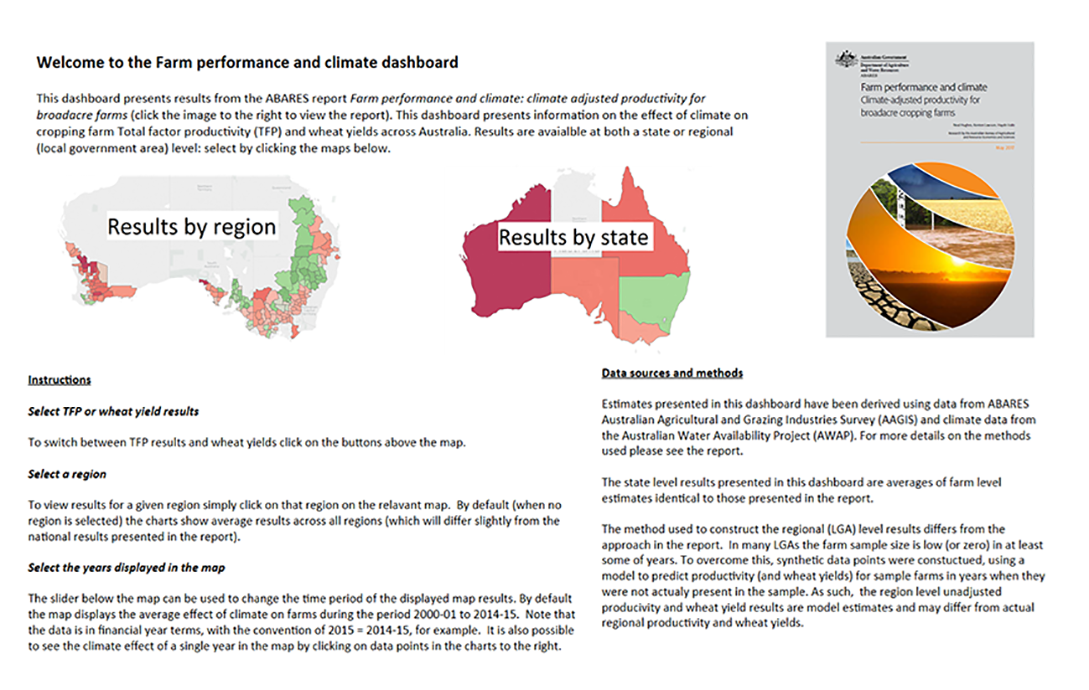 The Farm performance and climate report examines the effect of climate variability and climate change on the productivity of Australian broadacre cropping farms between 1977–78 and 2014–15.
The Farm performance and climate report examines the effect of climate variability and climate change on the productivity of Australian broadacre cropping farms between 1977–78 and 2014–15.
The study combines ABARES farm survey data with climate data to estimate the effect of climate variables (such as, rainfall and temperature) on both cropping farm Total Factor Productivity (TFP) and wheat yields.
The study also presents climate-adjusted productivity estimates with the effects of climate removed.
In addition, to the main report results from the analysis are presented in an interactive data visualisation.
Summary
[Expand all]
Motivation
This study examines the effect of climate variability and climate change on the productivity of Australian cropping farms between 1977–78 and 2014–15. The productivity of Australian cropping farms is heavily affected by climate variability, particularly the occurrence of droughts. While Australian farmers are well accustomed to managing this variability, the emergence of climate change is presenting some new challenges.
Climate change studies have consistently predicted changes in Australian rainfall, including lower rainfall in southern Australia, and more severe droughts and floods. During the past 20 years, large changes in Australia’s climate have been observed, including reductions in average winter rainfall in southern Australia and general increases in temperature (CSIRO & BoM 2014). Evidence suggests that these trends are at least partly due to climate change (CSIRO 2012, CSIRO & BoM 2016).
The Australian Bureau of Agricultural and Resource Economics and Sciences (ABARES) estimates total factor productivity (TFP) using data from its long running farm survey programmes. TFP measures the performance of the industry over time, including gains achieved through adoption of new technologies. As such, TFP is often used to evaluate the long-term effects of agricultural research and development (R&D) programmes.
ABARES productivity numbers are strongly correlated with climate conditions. These climate effects tend to obscure underlying trends in farm performance, particularly in the short-term. Although attention is usually placed on long-term trends, even these can become problematic in the presence of climate change. For an unbiased measure of farm performance, it is necessary to control for climate effects.
This study combines ABARES farm survey data with spatial climate data to estimate the effect of climate conditions (such as, rainfall and temperature) on cropping farm TFP. The study then presents climate-adjusted productivity estimates with the effects of climate removed. For comparison, similar results are generated for farm wheat yields using the same data sources and methods.
Key findings
Farm productivity slowed in the 1990s but rebounded in the 2000s
After removing the effects of climate, a clearer picture of underlying trends in farm productivity emerges (Figure 1).
A slowdown in productivity growth is apparent during the 1990s, with productivity growth of 2.1 per cent per year between 1977–78 and 1993–94, and just 0.2 per cent per year between 1993–94 and 2006–07. However, there is evidence of a significant rebound in climate-adjusted productivity since 2006-07, with annual growth of 1.5 per cent per year.
The results suggest that the vast majority of productivity growth in the cropping sector has occurred within two key periods: 1987–88 to 1993–94 and 2007–08 to 2013–14. Together, these periods account for 91.6 per cent of the total productivity gain between 1977–78 and 2014–15. A very similar pattern is observed in climate-adjusted wheat yields—the same two periods account for 91.1 per cent of the total gains.
These results demonstrate the importance of controlling for climate when measuring agricultural productivity. The trends are difficult to observe in the underlying data, given annual variability and the longer-term decline in average climate conditions.
Figure 1: Average climate-adjusted productivity for cropping specialist farms, 1977–78 to 2014–15

Climate change is affecting cropping farm productivity
The recent changes in climate have had a significant negative effect on the productivity of Australian cropping farms, particularly in south-western Australia and south–eastern Australia (Figure 2). In Western Australia, climate conditions between 2000–01 and 2014–15 lowered TFP by an average of 7.7 per cent—relative to what would have been seen under long-run average conditions (1914–15 to 2014–15). In New South Wales climate conditions post 2000–01 lowered productivity by an average of 6.5 per cent.
A similar pattern is observed for wheat yields, although the climate effects are larger. Climate conditions between 2000–01 and 2014–15 lowered national wheat yields by around 11.9 per cent relative to long-run conditions (16.3 per cent in Western Australia and 14.8 per cent in Victoria).
Although climate conditions for cropping have declined overall, some regions have been relatively unaffected or even experienced slight improvements since 2000–01, including the coastal high-rainfall zones of southern Australia, and parts of northern New South Wales and Queensland. In general, larger negative effects have occurred in lower-rainfall inland parts of the cropping zone (given these areas are more sensitive to rainfall decline) with smaller effects in higher-rainfall zones closer to the coast (where rainfall decline may have little effect on—or could even improve—productivity).
Figure 2: Map of average climate effect on productivity levels since 2000–01, (relative to the 1914–15 to 2014–15 average conditions)

Farmers are adapting to climate change
Strong growth in productivity since 2006–07 has helped the cropping industry to offset the decline in climate conditions. Further, the results suggest that these recent productivity improvements reflect adaptation to the changing climate.
Farm sensitivity to climate—as measured by the gap in productivity between good and bad years—increased consistently during the 1990s. During this period, there was an apparent focus on maximising performance in good years, which increased exposure to negative climate shocks. In more recent times, this trend has reversed, with significant declines in the sensitivity of farm productivity and wheat yields to climate since 2005–06.
The results suggest that farmers have adapted to the longer-term changes in climate by focusing on technologies and management practices that improve productivity during dry years. Anecdotal information suggests that farmers have made a variety of management practice changes—including adoption of conservation tillage—to better exploit summer soil moisture, as an adaptation to reduced winter rainfall.
There is also evidence of shifts in the location of cropping activity over time. Both ABARES and ABS data shows that the amount of cropping activity in higher-rainfall zones—such as south-western Victoria—has increased in recent decades. At the same time, there is evidence that cropping activity has decreased in some inland areas that have been heavily affected by the deteriorating climate.
Future research
In future, the ability of cropping farms to adapt to climate change will remain crucial to the success of the industry. Much of this adaptation will involve ‘incremental’ improvements in technology, driven by existing agricultural R&D systems. In the longer term, more ‘transformational’ adaptation could occur, including changes in land use.
In both cases, understanding the effects of climate on farm productivity will be important. Given long-term projections, productivity estimates that isolate climate effects will become necessary for assessing the performance of agricultural research, development and extension systems, and helping to guide future investment decisions. Further, given the large uncertainties surrounding any long-run change in land use, it will be important to monitor climate trends and their effects on farm profitability and land use as they gradually unfold.
With growing climate variability, agricultural risk management programmes—both public and private—are also likely to become increasingly important. In future, the models developed here could be extended to inform the design of government drought assistance programmes or to help price crop insurance contracts to support the development of private insurance markets.
Finally, the techniques developed in this study could be extended in a number of directions. In particular, the analysis could move beyond productivity to consider the effect of climate on farm inputs and outputs, costs and revenue, and ultimately profit. Similar methods could also be applied to larger datasets, particularly ABS Agricultural Census data. The larger sample sizes available in ABS data would allow more accurate results, greater regional and industry coverage, and a better understanding of land-use change.
Resources
[Expand all]
Farm performance and climate dashboard
Downloads and links
| Document | Pages | File size |
|---|---|---|
Full report PDF  |
21 | 2.2 MB |
Data visualisation Tableau  |
- | - |
Tables and charts XLSX  |
- | - |
If you have difficulty accessing these files, visit web accessibility for assistance.
Media
- ABARES Outlook Conference 8th March 2017 “Climate adjusted productivity on cropping farms: the slowdown and the rebound”

